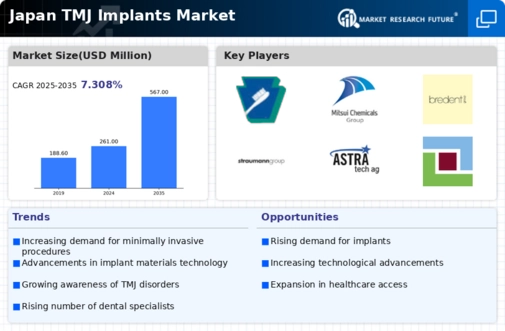The tmj implants market in Japan is characterized by a competitive landscape that is increasingly shaped by innovation, strategic partnerships, and regional expansion. Key players such as Stryker (US), Zimmer Biomet (US), and DePuy Synthes (US) are actively pursuing strategies that emphasize technological advancements and enhanced patient outcomes. Stryker (US), for instance, has focused on integrating digital solutions into its product offerings, which appears to enhance surgical precision and patient recovery times. Meanwhile, Zimmer Biomet (US) has been investing in research and development to expand its product portfolio, indicating a commitment to maintaining a competitive edge through innovation. Collectively, these strategies contribute to a dynamic environment where companies are not only competing on product quality but also on the ability to deliver comprehensive solutions that address patient needs.
In terms of business tactics, companies are increasingly localizing manufacturing to reduce costs and improve supply chain efficiency. This approach is particularly relevant in the context of Japan's regulatory landscape, which often necessitates compliance with stringent local standards. The market structure can be described as moderately fragmented, with several key players holding significant market shares while also allowing for the presence of smaller, specialized firms. This fragmentation suggests that while major companies dominate, there remains ample opportunity for niche players to carve out their own segments within the market.
In October 2025, DePuy Synthes (US) announced a strategic partnership with a leading Japanese medical institution to develop advanced tmj implant solutions tailored to local patient demographics. This collaboration is likely to enhance the company's understanding of regional needs and preferences, thereby positioning it favorably in a competitive market. Such partnerships not only facilitate knowledge transfer but also enable companies to leverage local expertise, which is crucial for successful product development and market penetration.
In September 2025, KLS Martin (DE) launched a new line of tmj implants that incorporate bioactive materials designed to promote faster healing. This innovation reflects a growing trend towards the use of advanced materials in medical devices, which may significantly improve patient outcomes. The introduction of such products could potentially shift market dynamics, as competitors may need to accelerate their own R&D efforts to keep pace with these advancements.
In August 2025, Medtronic (US) expanded its distribution network in Japan by partnering with local healthcare providers, aiming to enhance accessibility to its tmj implant products. This strategic move underscores the importance of distribution channels in the competitive landscape, as companies seek to ensure that their innovations reach the intended patient populations effectively. By strengthening its presence in the local market, Medtronic (US) is likely to bolster its competitive position against other major players.
As of November 2025, the competitive trends in the tmj implants market are increasingly influenced by digitalization, sustainability, and the integration of artificial intelligence (AI) into product development and patient care. Strategic alliances are becoming more prevalent, as companies recognize the value of collaboration in driving innovation and improving operational efficiencies. Looking ahead, it appears that competitive differentiation will increasingly hinge on factors such as technological innovation, supply chain reliability, and the ability to deliver tailored solutions, rather than solely on price. This shift suggests a maturation of the market, where the focus is on creating value through advanced technologies and enhanced patient experiences.























Leave a Comment